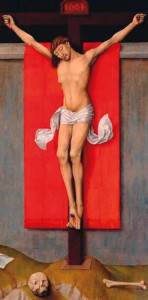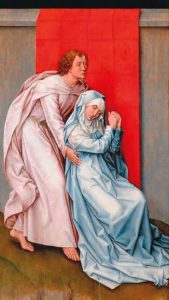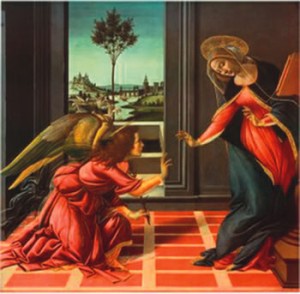Mary for Today:- Mary for the Third Millennium (4)
Ecumenical
Introduction
The great document of Paul VI, Marialis Cultus, published ten years after Vatican Council II, called for a devotion to Mary that was ecumenically sensitive, especially to the centrality of Christ. We need to recognise how much we ourselves contributed in the past to the Protestant reaction against Mary. The historical roots lie in the 16th century where calls for reform in head and members were ignored by a papacy under Julius II (1503-1513) whose main concern was to reinforce the political power of the papacy, and Leo X (1513-1521) whose intent was to strengthen the church through an impressive building programme centred on the construction of the new basilica of St Peter’s in Rome. Sadly, the Council of Trent in 1545 came too late to channel the powerful reform movements in Switzerland and Germany.
A December Mary
Mary, the mother of Jesus, is someone many Protestants meet only at Christmas, the sweet figure on cards and in carols, praised for her ‘yes’ to God and then retired for another year with the cards and carols into a storage box. The reaction in Protestantism to Roman Catholic veneration and doctrine has its roots in the Reformation where the Theotokos or God-bearer had been elevated to dizzying heights. This aversion from a time of excess, inherited by Protestantism, makes Mary a victim of conscientious neglect. But the question is rising as to whether this neglect is fair to the Mary of the Scriptures. Has the Protestant tradition starved itself of a potentially significant contribution to their understanding of faith, discipleship, and ‘the feminine face of the church’ (R. R. Ruether’s term)?
Sola Scriptura, Scriptue Alone
The priority Protestantism is so fond of claiming, ‘scripture alone’, opens a mutually shared path to reclaim the figure of Mary for Protestants, one grounded in the scriptural accounts. What matters for this approach is what is on the pages in front of us. Mary has so much to offer, especially in the area of discipleship. Neglect of her is a tragedy that robs the church of an understanding of what it means to be a follower of Jesus. Mary was a thoughtful, faithful, humble, prayerful, patiently enduring woman, passionate about the priorities of God. With John’s Beloved Disciple she stands as Woman and Mother at the foot of the cross, “models for Jesus’ own true family” which any church must aspire to be.
Mary in the New Testament
A recent Anglican and Roman Catholic consensus on the Eucharist is another positive step on the road towards Christian unity. In the 70s two significant achievements of biblical scholarship, collaborative literary works by Protestant, Anglican, and Catholic scholars, produced substantial agreements recorded in two volumes: Peter in the New Testament (1973) and Mary in the New Testament (1978). Seeing the old problems that separated the churches in a new light calls for an honest appreciation of historical and scriptural issues, especially when it comes to agreement on what the oldest Christian sources said.
Did Protestant Origins reject Mary?
Ulrich Zwingli (1484-1531), at the beginning of the Swiss Reformation, was chaplain to the monastery of Einsiedeln. His main task was to preach to the pilgrims who paid honour to a famous statue of the Virgin. He often preached on the Mother of Jesus, her annunciation, and her presence at Pentecost. He may well be regarded as the most Marian figure of the Reformation. He stood by the tradition of Matthew 12:48 where the visit of “the mother of Jesus and his brothers” is simply a reminder of the subordination of human families to God: “for how could he who teaches to honour one’s mother, humiliate his own?” (Zwingli HZO 297-8). He honoured Joseph for his protection of Mary from the Law.
Zwingli assumed that good Catholics are in the habit of praying the Hail Mary, though he knew only the scriptural first part of the prayer without its later addition. Given her relationship to Jesus, he saw it as right to praise her, but not to invoke or pray to her. He insisted, “The Ave Maria is not a prayer, but a greeting and a praise” – the greeting of the archangel Gabriel at the annunciation and of Elizabeth at the visitation. He affirmed her permanent virginity and wrote of her sinlessness, “she was without the smallest trace of a sin.” The only doctrine not reflected in his preaching was the Assumption. He asserted: “Who then has ever known God better than the one Virgin Mary? If you wish especially to honour Mary, follow her purity, her innocence, and her strong faith.” 
Martin Luther (1483-1546)
Neither a pastor or chaplain but an Augustinian friar and Scholastic theologian, Luther preached on the traditional feast days of Mary and wrote a fine commentary on Mary’s Magnificat. From Mary’s song one should draw “wholesome knowledge and a praiseworthy life.” One should hope also “to chant and sing it eternally in heaven.” The doctrine in the commentary is sound in its Christology and links with the saving work of Christ. “Mary sings most sweetly of the fear of the Lord, what manner of lord He is, and especially what his dealings are with those of high and of low degree.” Devotionally Luther does not hesitate to wish for Mary’s help in his writing: “May the tender Mother of God herself, procure for me the spirit of wisdom, profitably and thoroughly to expound this song of hers…” He concludes: “May Christ grant us this through the intercession and for the sake of his dear Mother Mary. Amen.”
The human face of Mary was something Luther honoured: “She was but a simple maiden, tending the cattle and doing the housework, and doubtless esteemed no more than any poor maidservant today.” And yet Christ “is born of the despised stem (i.e. the impoverished line of David), of the poor and lowly maiden.” Luther maintained the traditional doctrines of Mary’s virginity and title of Mother of God: “She became a mother in a supernatural manner without violation of her virginity.” “She sang her song to the glory of God, not for herself alone but for us all that we should sing it after her.”
Conclusion
To leave Mary out is to betray the Scriptures. She is the main female example of discipleship amongst a number of males. To continually ask women to try to identify with male models of discipleship subtly undermines the value of their femaleness. She stood alongside the Beloved Disciple, making her an example for both men and women. Would it not be wonderful, something to be striven for, that in taking the longing for unity seriously, we could find in Mary a source for unity instead of division, realising that we have more that unites us than divides us, and we could sing Mary’s song together? Dare we hope for a Marian revival in the face of the sad truth that apart from a few exceptions the evangelical churches have lost practically all interest in Mary. And what can we say of our own?
Sources:
Rosemary Dewerse, Reclaiming Mary, in Reality #66, 2005. This material is reproduced with permission from Reality magazine. For more great articles go to www.reality.org.nz
George Tavard, The Thousand Faces of Mary, Michael Glazier, 1996.



 Entries(RSS)
Entries(RSS)